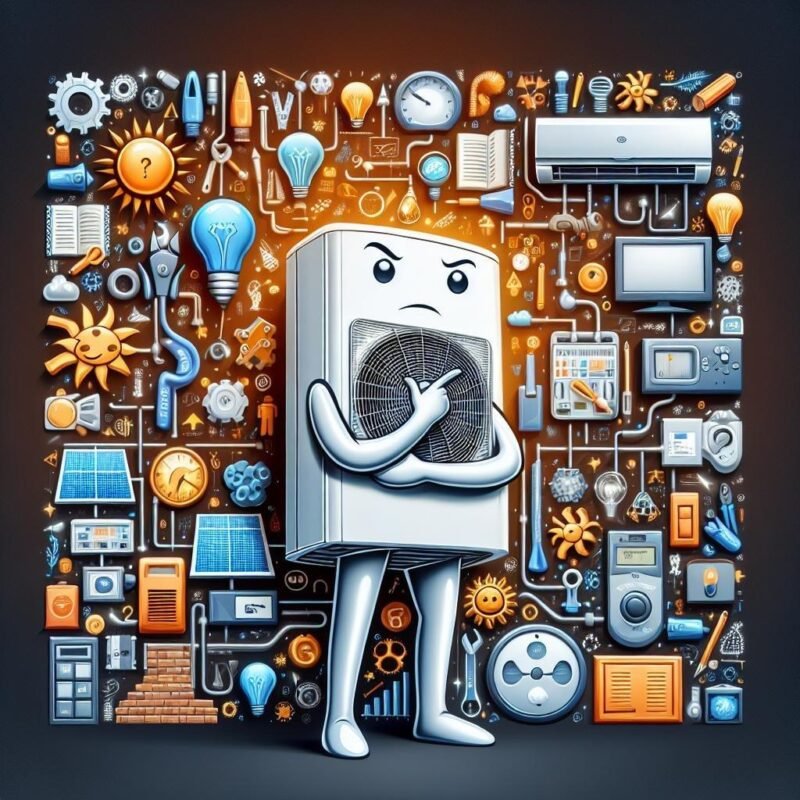A Guide to Troubleshooting Common Mini Split AC Problems

Picture this: a scorching summer day, your trusty mini split AC decides too throw a tantrum, and you’re left wondering why your slice of paradise turned into a sauna. We’ve all been there! Whether it’s mysterious noises, inconsistent cooling, or that dreaded water drip, mini split systems can sometimes test our patience.But fear not! this guide will walk you through the most common mini split headaches and their solutions, turning you from a frustrated homeowner into a confident troubleshooter. After all, understanding your AC’s quirks is half the battle won – and we’re here to help you win the cooling game!
Strange Noises and Weird Vibrations: When Your Mini Split Starts Speaking in Tongues
Ever noticed your mini split making sounds like it’s auditioning for a horror movie? those bangs, whistles, and mysterious vibrations aren’t your unit’s attempt at creating a supernatural soundtrack. Your once-quiet cooling companion might be sending distress signals through thes unexpected symphonies. From the subtle clicking that sounds like tiny elves tap-dancing inside the unit to the concerning rattles that make you wonder if your AC is secretly harboring a whole percussion section,these auditory warnings deserve your attention.
Let’s decode this mechanical orchestra and identify what your unit might be trying to tell you:
- Buzzing and Humming: Usually points to loose parts or electrical issues
- Clicking and Ticking: Normal during startup/shutdown, but constant clicking needs attention
- Whooshing or Gurgling: Could be refrigerant flow or drainage issues
- Screeching or Metal-on-Metal: Fan motor problems or failing bearings
| Sound Type | Urgency Level | DIY Check? |
|---|---|---|
| Rattling | Medium | Yes |
| Screeching | High | No |
| Clicking | Low | yes |
Ice Formation and poor Cooling: Dealing with Frozen Dreams and Sweaty Reality
When your mini split starts resembling an arctic expedition gone wrong, you’re facing a classic cooling conundrum. That glistening layer of frost on your evaporator coil isn’t just pretty to look at – it’s actually a silent efficiency killer that’s making your system work harder than a penguin in a sauna. Common culprits include low refrigerant levels, restricted airflow, or a faulty defrost cycle that’s decided to take an unscheduled vacation.
Simultaneously occurring, if your room feels more like a tropical rainforest despite your AC running full blast, you might be dealing with some sweaty setbacks. Here’s what you shoudl check:
- Dirty or clogged air filters blocking the cool vibes
- Refrigerant levels playing hide and seek
- Outdoor unit throwing a heat party
- indoor fan living life in slow motion
| Symptom | Speedy Fix |
|---|---|
| Ice Formation | defrost cycle + fan only mode |
| Poor cooling | Clean filters + clear debris |
Error Codes and Flashing Lights: Decoding Your Mini Split’s Secret Language
Like a secret code waiting to be cracked, your mini split system communicates through a series of flashing lights and numerical codes. These mysterious signals aren’t meant to confuse you – they’re your unit’s way of waving a red flag when something’s not quite right. Whether it’s a single blinking LED or a digital display showing E1 or F4, understanding these indicators can save you time and possibly costly repairs.
let’s demystify the most common signals your system might display:
- 1 Flash: Typically indicates a communication error between units
- 2 Flashes: Often signals a temperature sensor issue
- 3 Flashes: Usually points to a refrigerant problem
- Continuous Blinking: Could mean a defrost cycle or power issue
| Error Code | Meaning | Initial Action |
|---|---|---|
| E1 | Indoor Unit Error | Reset Power |
| E2 | Sensor Fault | Check Connections |
| F4 | Outdoor Unit Error | Clear Debris |
Leaks and Drainage Drama: keeping Your Indoor Unit from crying All Day Long
Why does your indoor unit insist on making its own indoor waterfall? nobody likes unexpected drips from their AC, especially when they land on your favorite couch or that expensive area rug. These pesky leaks often stem from clogged condensate lines, frozen evaporator coils, or simply a unit that’s not properly leveled. Think of your mini split as a dehumidifier on steroids – it’s constantly pulling moisture from the air,and all that water needs somewhere to go!
Before you grab your umbrella for indoor use,let’s address these weepy woes.Here are the usual suspects behind your unit’s excessive tears:
- Dirty air filters blocking proper drainage
- Damaged or disconnected drain lines
- Poor installation angle preventing proper water flow
- Frozen coils creating overflow when thawing
| Drainage Issue | Quick Fix |
|---|---|
| Clogged Line | Vacuum Clean |
| Tilted Unit | level Adjustment |
| Frozen Coils | Thaw & Clean |
Q&A
Q&A: A Guide to Troubleshooting Common Mini Split AC Problems
Q1: what should I do if my mini split AC isn’t cooling?
A1: First things first, don’t panic! Check the thermostat settings to make sure it’s set to “cool” and the desired temperature is lower than the current room temperature. If it’s still not cooling, inspect the air filters. A dirty filter can block airflow, making your AC work harder than a marathon runner with ankle weights! Clean or replace them regularly to let your system breathe easy.
Q2: I here strange noises coming from my mini split AC. Is that normal?
A2: A little whirring or soft humming is normal, but if your mini split sounds more like a rock concert, it’s time to tune in! Common culprits include loose components or debris blocking the fan. Check to see if anything is rattling around. If the noise persists, it might be wise to call in the pros—for peace of mind, if nothing else!
Q3: There’s water pooling around my indoor unit. What could be the issue?
A3: Uh-oh! It sounds like your mini split may be experiencing a case of “drip, drip, drop.” Water pooling can be a sign of a clogged drain line or a frozen coil. First, turn it off and give it some time to thaw if necessary. Then, check the drain line for blockages. If you’re not sure were to start, a amiable technician can definitely help get you back in the clear!
Q4: Why does my mini split keep turning on and off (short cycling)?
A4: short cycling can feel like the annoying friend who can’t decide if they want to stay or leave! It might be due to an oversized unit, incorrect thermostat settings, or even a dirty air filter. Ensure that your mini split is appropriately sized for your space and that the filters are squeaky clean. If the problem persists,it could be time to call in a specialist to check for refrigerant issues.
Q5: How can I improve the efficiency of my mini split AC?
A5: You’re on the right track to cool success! Start by ensuring that your outdoor unit is clear of debris—think leaves, dirt, and the occasional lost toy. Additionally, keep your indoor space shaded during hot days with curtains or blinds to reduce the workload on your AC.Regular maintenance, like cleaning filters and scheduling annual check-ups, will also keep your mini split running efficiently, like a well-oiled machine!
Q6: Is it normal for my mini split AC to smell strange?
A6: While “fragrance of cool air” would be a hit in the perfume aisle, weird odors are a cause for concern! Musty smells could indicate mold or mildew in the unit, while a burning smell might suggest electrical issues. Turn off your AC and check the filters; a good cleaning might do the trick! If strange scents linger, don’t hesitate to call a technician for a thorough inspection.
Q7: How often should I be servicing my mini split AC?
A7: Think of your mini split AC as a beloved pet that needs regular check-ups. Ideally, annual service from a qualified technician will keep things running smoothly. You can handle the small stuff, like cleaning or replacing filters every 1-3 months, depending on usage. It’s all about balance—your mini split will thank you with years of cool air and comfort!
With these friendly tips in hand, you’ll be well-equipped to tackle common mini split AC problems like a pro! Remember, regular maintenance is key to ensuring your AC keeps you comfortable all season long. Happy troubleshooting!
Key Takeaways
As we wrap up our journey through the world of mini split AC troubleshooting, we hope you’ve found this guide not just informative, but also empowering. Just like nurturing a delicate plant, taking care of your mini split system requires a pinch of knowledge and a splash of patience. Remember, every hiccup has a fix, and whether it’s a rebellious remote or an uncooperative compressor, you now have the tools to tackle those mini challenges head-on.
So the next time your comfort zone gets disrupted, don’t sweat it! Dive into that user manual, put on your detective hat, and bring out your inner HVAC hero. And if all else fails, there’s always a pro ready to lend a hand. Here’s to cool breezes and cozy spaces—may your summers be chill and your mini splits run smooth. Stay cool, friends!






















